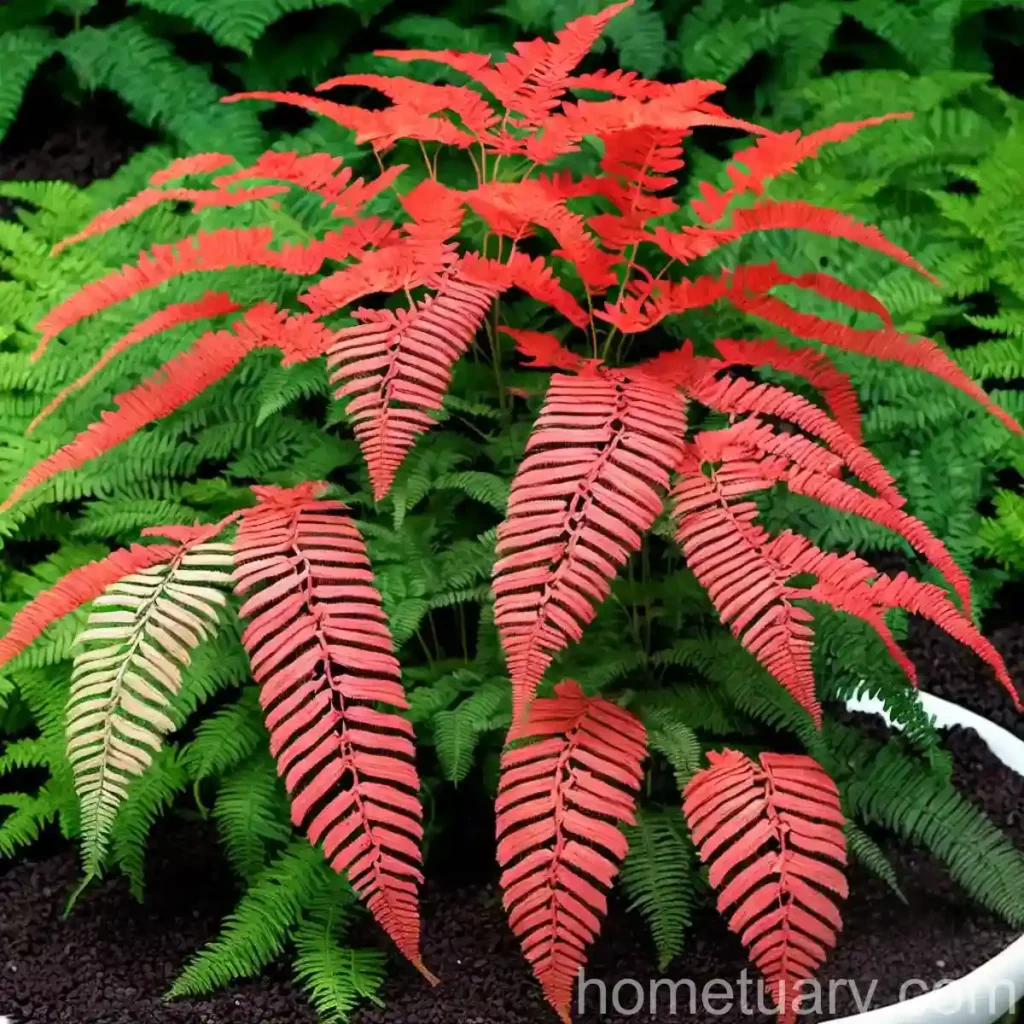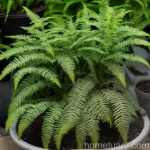The Fascinating World of Japanese Painted Fern (Athyrium niponicum var. pictum ‘Red Beauty’)
In the realm of ornamental plants, ferns have always held a special allure. Their delicate fronds and intricate patterns add an ethereal touch to any garden or landscape. Among the myriad of fern species, the Japanese painted fern (Athyrium niponicum var. pictum ‘Red Beauty’) stands out for its captivating foliage and versatility. In this comprehensive guide, we will delve into the realm of this enchanting plant, exploring its culture, uses, care requirements, and much more.
What is the Japanese Painted Fern (Athyrium niponicum var. pictum ‘Red Beauty’)?
The Japanese painted fern, scientifically known as Athyrium niponicum var. pictum ‘Red Beauty’, is a striking deciduous fern revered for its unique and vibrant foliage. Belonging to the family Athyriaceae, this fern is native to Japan, where it thrives in the cool, moist woodland environments. With its lacy fronds and exquisite coloration, it is a sought-after choice for shaded gardens, woodland settings, and container plantings.
Key Takeaways
Before we embark on a detailed exploration of the Japanese painted fern, let’s highlight the key takeaways for quick reference:
- Plant Name: Athyrium niponicum var. pictum ‘Red Beauty’
- Common Names: Japanese painted fern, Red Beauty fern
- Foliage: Intricately patterned silvery-green fronds with a striking blend of burgundy, maroon, and red tones
- Growth Habit: Clumping, mounding
- Height: 12-18 inches
- Spread: 18-24 inches
- Hardiness Zones: 4-8
- Uses: Shaded gardens, woodland settings, container plantings
- Notable Features: Variegated foliage, tolerance to shade, low maintenance
Now, let’s delve into the various aspects of this captivating fern, understanding its culture, uses, and essential care requirements.
Culture
Understanding the cultural preferences and requirements of the Japanese painted fern is essential for fostering its optimal growth and vibrant foliage. Let’s explore the key cultural aspects of this remarkable plant:
Water
Japanese painted ferns thrive in consistently moist soil, making them an excellent choice for areas with ample rainfall or in gardens with irrigation systems. While they prefer moist conditions, it is crucial to ensure that the soil is well-draining to prevent waterlogging, which can lead to root rot and other issues.
- Watering Frequency: Regular, especially during dry spells
- Moisture Requirements: Consistently moist soil
- Watering Method: Direct at the base to avoid wetting the foliage
Sunlight
In its natural habitat, the Japanese painted fern flourishes in the dappled shade of woodland canopies, making it well-suited for shaded or partially shaded environments. When cultivated in the garden, it is essential to provide it with the appropriate amount of shade to preserve the integrity of its striking foliage.
- Light Requirements: Partial to full shade, dappled sunlight
- Ideal Conditions: Sheltered locations with indirect light
- Avoid: Prolonged exposure to direct sunlight, especially in hot climates
Soil
The Japanese painted fern thrives in rich, well-amended soil with good moisture retention properties. While not excessively demanding in its soil requirements, providing it with a fertile growing medium lays the foundation for robust growth and vibrant foliage.
- Soil Type: Moist, well-draining
- Acidity: Slightly acidic to neutral (pH 5.5-7.0)
- Soil Amendments: Organic matter, compost
- Mulching: Beneficial to retain moisture and suppress weeds
Fertilizer
Although not heavy feeders, Japanese painted ferns benefit from occasional fertilization to bolster their growth and ensure the development of vivid foliage. A balanced, slow-release fertilizer applied in the spring provides the necessary nutrients for robust and healthy fronds.
- Fertilizer Type: Balanced, slow-release
- Application Time: Early spring
- Frequency: Once per year
- Dilution: Follow manufacturer’s guidelines for dilution and application rates
Pruning
Pruning plays a minimal role in the care of Japanese painted ferns, as their tidy growth habit and graceful fronds require little intervention. The primary focus of pruning is on the removal of withered or damaged fronds, enhancing the overall aesthetics of the plant.
- Pruning Time: Early spring or as needed
- Technique: Using sterile pruning shears, remove spent fronds at the base
- Clean-Up: Dispose of removed fronds to prevent disease spread
- Aesthetic Considerations: Prune to maintain a neat and compact appearance
Propagation
The propagation of Japanese painted ferns offers enthusiasts the opportunity to expand their collection and share the beauty of this plant with others. While it can be propagated through spores, the most common and reliable method for home gardeners is division.
- Propagative Method: Division
- Ideal Time: Spring or early fall
- Procedure: Carefully divide the clumps, ensuring each division has well-established roots and fronds
- Replanting: Place divisions in prepared soil and water thoroughly
- Establishment: Provide consistent moisture until new growth appears
Container Popularity
The Japanese painted fern’s excellent adaptability to container cultivation makes it a favored choice for adding elegance and charm to garden spaces, patios, and balconies. Its striking foliage and modest size render it a versatile option for various container designs and arrangements.
- Container Type: Shallow, wide containers
- Soil: Well-draining, high-quality potting mix
- Drainage: Adequate drainage holes
- Watering: Monitor moisture levels closely, especially during dry periods
- Overwintering: Protect from harsh frosts, consider providing insulation or moving containers to sheltered areas
Common Diseases
While generally resilient, Japanese painted ferns can be susceptible to certain diseases and ailments, especially in unfavorable growing conditions. Understanding and identifying common diseases is crucial for implementing timely and effective management strategies.
Disease Diagnosis
Anthracnose: This fungal disease manifests as small, water-soaked lesions on the fronds, eventually leading to browning and wilting. It thrives in warm, humid conditions, making vigilant monitoring and prompt intervention essential.
Rust: Recognizable by the presence of orange or brown spore-producing structures on the fronds, rust can weaken the plant and compromise its overall vigor.
Rhizoctonia Crown Rot: This soil-borne pathogen can cause the rotting of the plant’s crown, resulting in stunted growth and wilting fronds. It is typically favored by overly moist conditions and poor soil drainage.
Disease Management
- Cultural Practices: Implement proper spacing, adequate air circulation, and healthy soil conditions to discourage disease development.
- Sanitation: Remove and dispose of affected fronds and plant debris to prevent the spread of diseases.
- Fungicidal Treatments: When necessary, apply suitable fungicides following the manufacturer’s instructions to mitigate disease progression.
Common Pests
Japanese painted ferns are relatively resistant to pest infestations, but certain pests may pose occasional challenges to their health and vigor. Vigilance and prompt action are crucial for addressing pest issues and safeguarding the plant’s well-being.
Pests
Slugs and Snails: These voracious feeders can inflict damage by consuming the delicate fronds of the Japanese painted fern, especially in moist and shaded environments.
Scales: Scale insects may colonize the fronds, excreting sticky honeydew and causing weakening of the plant.
Aphids: Although less common, aphids may occasionally target the foliage of the plant, requiring intervention to prevent widespread infestations.
Pest Control
- Physical Removal: Handpick slugs and snails, especially during the evening, when they are most active.
- Barriers: Implement barriers, such as copper tape, to deter slugs and snails from reaching the plant.
- Horticultural Oils: Apply horticultural oils or insecticidal soaps to combat scale insects and aphids, ensuring thorough coverage of affected areas.
Botanist’s Tips
As a plant scientist deeply immersed in the realm of ferns and botanical wonders, I offer the following insights and tips for cultivating and appreciating the exquisite Japanese painted fern:
Cultivation Recommendations
- Optimal Environment: Choose shaded or partially shaded locations with rich, well-draining soil for the Japanese painted fern’s best performance.
- Mulching Benefits: Apply a layer of organic mulch around the base of the plant to conserve moisture and suppress weed growth while enhancing the soil’s organic content.
- Watering Considerations: Monitor soil moisture levels closely, especially during hot and dry periods, to maintain the ideal growing conditions for the fern.
Appreciation and Design
- Companion Planting: Pair Japanese painted ferns with shade-loving companions such as hostas, epimediums, and tiarellas to create captivating woodland-inspired garden arrangements.
- Seasonal Observations: Observe and appreciate the seasonal changes in the fern’s foliage, from the emergence of delicate fronds in spring to the autumnal transformations that add a final burst of color to the garden.
Conservation and Preservation
- Habitat Preservation: Support conservation efforts aimed at preserving the natural habitats of Japanese painted ferns and other native plant species, recognizing their ecological significance and intrinsic value.
Fun Facts
Unraveling the fascinating allure of the Japanese painted fern extends beyond its ornamental appeal. Here are some intriguing and delightful facts about this captivating plant:
- The unique coloration and patterns adorning the fronds of the Japanese painted fern have earned it the epithet “living botanical artwork.”
- The varietal name “pictum” is derived from the Latin word for “painted,” alluding to the fern’s evocative foliage.
- Japanese painted ferns have been appreciated in traditional Japanese gardens for centuries, admired for their serene beauty and graceful presence.
- The varied color palette of the Japanese painted fern’s fronds can subtly shift depending on the light and environmental conditions, creating a dynamic display throughout the growing season.
Links to External Resources
For further exploration and in-depth information on the Japanese painted fern, I invite you to explore the following resources:
- Royal Horticultural Society – Athyrium niponicum var. pictum ‘Red Beauty’
- Missouri Botanical Garden – Japanese Painted Fern
- University of Florida – Japanese Painted Fern in the Garden
- The American Fern Society
In conclusion, the Japanese painted fern (Athyrium niponicum var. pictum ‘Red Beauty’) stands as a testament to the enchanting diversity and beguiling beauty found within the realm of ferns. Its subtle elegance, vibrant foliage, and adaptability foster a deep appreciation for this captivating plant, portraying its significance in both ornamental horticulture and botanical admiration.
Through understanding its culture, uses, and care requirements, we can unlock the full potential of the Japanese painted fern, harnessing its allure to create enchanting garden settings and fostering a profound connection with the intricate wonders of the natural world.















